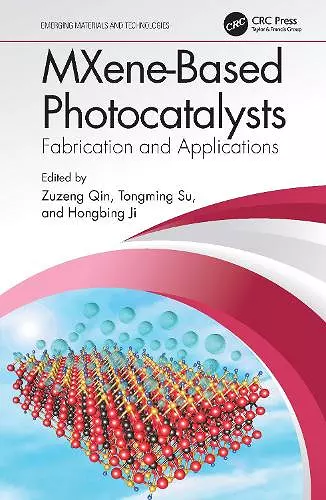MXene-Based Photocatalysts
Fabrication and Applications
Tongming Su author Hongbing Ji author Tongming Su editor Hongbing Ji editor Zuzeng Qin editor
Format:Hardback
Publisher:Taylor & Francis Ltd
Published:21st Feb '22
Should be back in stock very soon

MXene, a two-dimensional (2D) transition metal carbide, nitride, and carbonitride, was discovered in 2011. MXene has great potential as a cocatalyst in the field of photocatalysis due to its unique properties and structure. MXene-Based Photocatalysts: Fabrication and Applications introduces readers to the fundamentals, preparation, microstructure characterization, and a variety of applications of MXene-based photocatalysts. The book is a comprehensive reference for MXene materials and provides an overview of the current literature on MXene-based photocatalysts.
FEATURES
- Discusses preparation methods of MXenes
- Describes the morphology and microstructure of MXenes
- Offers strategies for fabricating MXene-based photocatalysts
- Details the reaction mechanism of MXene-based photocatalysts
- Covers applications in photocatalytic water-splitting, photocatalytic CO2 reduction, photocatalytic degradation, photocatalytic nitrogen fixation, and photocatalytic H2O2 production
This book serves as an invaluable guide for advanced students, industry professionals, professors, and researchers in the field of materials science and engineering, photocatalysis, energy, and environmental applications.
High on the list of critically important environmental technologies likely to play an increasing leadership role in coming decades are photocatalytic processes for energy conversion driven by MXene-based photocatalysts. Synthesized for the very first time in 2011, these novel, next-generation transition metal carbides and nitrides offer attractive new alternative pathways to high-value materials chemistries realized from water-splitting, carbon dioxide reduction, lithium-ion batteries, solar energy manufacturing—and the list could go on. Drawing contributions from Asian constituencies in China and Malaysia, editors Qin, Su (both, Guangxi Univ.), and Ji (Sun Yat-sen Univ.) offer a notable monograph beginning with a two-page introduction useful for a broader audience. Specialized chapters outlining preparatory methods, morphology, and microstructure of MXene-based photocatalysts and characteristic properties of MXene itself and MXene-facilitated photocatalysis follow. Concluding chapters deal more extensively with various industrial fabrication methods and applications. Each chapter is well documented with references current to 2021. Illustrations, mainly in black-and-white, are typically small and often hard to read but suitable and helpful. This is important stuff and well researched. Advanced undergraduates and professionals working in the field will be pleased to have access to this volume—as was this reviewer.
Summing Up: Highly recommended. Upper-division undergraduates. Graduate students, faculty, and professionals. Students in two-year technical programs.
–L. W. Fine, Columbia University, CHOICE, May 2023
High on the list of critically important environmental technologies likely to play an increasing leadership role in coming decades are photocatalytic processes for energy conversion driven by MXene-based photocatalysts. Synthesized for the very first time in 2011, these novel, next-generation transition metal carbides and nitrides offer attractive new alternative pathways to high-value materials chemistries realized from water-splitting, carbon dioxide reduction, lithium-ion batteries, solar energy manufacturing—and the list could go on. Drawing contributions from Asian constituencies in China and Malaysia, editors Qin, Su (both, Guangxi Univ.), and Ji (Sun Yat-sen Univ.) offer a notable monograph beginning with a two-page introduction useful for a broader audience. Specialized chapters outlining preparatory methods, morphology, and microstructure of MXene-based photocatalysts and characteristic properties of MXene itself and MXene-facilitated photocatalysis follow. Concluding chapters deal more extensively with various industrial fabrication methods and applications. Each chapter is well documented with references current to 2021. Illustrations, mainly in black-and-white, are typically small and often hard to read but suitable and helpful. This is important stuff and well researched. Advanced undergraduates and professionals working in the field will be pleased to have access to this volume—as was this reviewer.
Summing Up: Highly recommended. Upper-division undergraduates. Graduate students, faculty, and professionals. Students in two-year technical programs.
–L. W. Fine, Columbia University, CHOICE, May 2023
ISBN: 9780367742904
Dimensions: unknown
Weight: 453g
212 pages